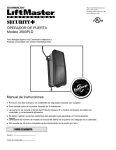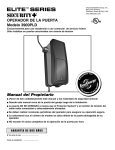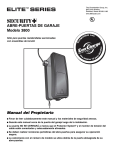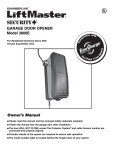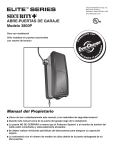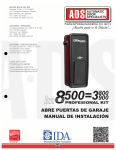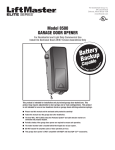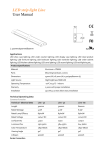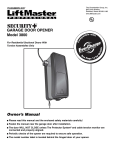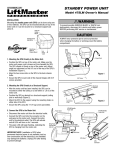Download Chamberlain Security+ 3900PLD User's Manual
Transcript
The Chamberlain Group, Inc. 845 Larch Avenue Elmhurst, Illinois 60126-1196 www.liftmaster.com ® DOOR OPERATOR Model 3900PLD pa e with tibl Owner’s Manual Se De tails Co m For Light Duty Commercial Use Install On Sectional Doors With Torsion Assemblies Only r eP fo age 13 ■ Please read this manual and the enclosed safety materials carefully! ■ Fasten the manual near the door after installation. door WILL NOT CLOSE unless The Protector System® and cable tension monitor are connected and properly aligned. ■ The ■ Periodic checks of the operator are required to ensure safe operation. ■ The ■ model number label is located behind the hinged door of your operator. Do NOT exceed 10 complete cycles of door operation per hour. 2 YEAR WARRANTY Serial # (located on electrical box cover) Installation Date TABLE OF CONTENTS Introduction 2-5 Operation Safety symbol review and signal word review . . . . . . . . . . 2 Planning . . . . . . . . . . . . . . . . . . . . . . . . . . . . . . . . . . . . . . 3 Preparing your door . . . . . . . . . . . . . . . . . . . . . . . . . . . . . . 4 Tools needed . . . . . . . . . . . . . . . . . . . . . . . . . . . . . . . . . . . 4 Specifications . . . . . . . . . . . . . . . . . . . . . . . . . . . . . . . . . . . 4 Carton inventory . . . . . . . . . . . . . . . . . . . . . . . . . . . . . . . . . 5 Hardware inventory . . . . . . . . . . . . . . . . . . . . . . . . . . . . . . 5 Assembly Operation safety instructions . . . . . . . . . . . . . . . . . . . . . . 21 Using your door operator . . . . . . . . . . . . . . . . . . . . . . . . . 21 Care of your operator . . . . . . . . . . . . . . . . . . . . . . . . . . . . 22 Having a problem? (Troubleshooting) . . . . . . . . . . . . 23-24 Diagnostic Chart. . . . . . . . . . . . . . . . . . . . . . . . . . . . . . . . 25 Programming Attach the collar to the operator. . . . . . . . . . . . . . . . . . . . . 6 Attach mounting bracket to the operator . . . . . . . . . . . . . . 6 7-16 Installation safety instructions . . . . . . . . . . . . . . . . . . . . . . 7 Position the operator . . . . . . . . . . . . . . . . . . . . . . . . . . . . . 7 Attach the emergency release rope and handle . . . . . . . . 8 Install power door lock (Not Provided) . . . . . . . . . . . . . . . . 8 Attach the cable tension monitor (Required) . . . . . . . . . . . 9 Install the single button control station. . . . . . . . . . . . . . . 10 Install the light (Not Provided) . . . . . . . . . . . . . . . . . . . . . 11 Electrical requirements. . . . . . . . . . . . . . . . . . . . . . . . . . . 12 Mount the Standby Power Unit (SPU) (Not Provided) . . . 13 Install The Protector System®. . . . . . . . . . . . . . . . . . . 14-16 Adjustment 26-28 To add or reprogram a hand-held remote control (Not Provided) . . . . . . . . . . . . . . . . . . . . . 26 To erase all codes from motor unit memory . . . . . . . . . . 26 3-Button remote . . . . . . . . . . . . . . . . . . . . . . . . . . . . . . . . 26 The remote control battery . . . . . . . . . . . . . . . . . . . . . . . . 26 To add, program or change a keyless entry PIN (Not Provided) . . . . . . . . . . . . . . . . . . . . . . . . . . . . . . 27 Programming remote light (Not Provided) . . . . . . . . . . . . 28 6 Installation 21-25 Repair Parts 29 Installation parts . . . . . . . . . . . . . . . . . . . . . . . . . . . . . . . . 29 Motor unit assembly parts . . . . . . . . . . . . . . . . . . . . . . . . 29 Accessories Notes Repair Parts and Service 30 31 Back Page 17-20 Program the travel limits . . . . . . . . . . . . . . . . . . . . . . . . . 17 Setting the force . . . . . . . . . . . . . . . . . . . . . . . . . . . . . . . . 18 Test the safety reversal system . . . . . . . . . . . . . . . . . . . . 19 Test The Protector System® . . . . . . . . . . . . . . . . . . . . . . . 19 Test cable tension monitor . . . . . . . . . . . . . . . . . . . . . . . . 20 To open door manually . . . . . . . . . . . . . . . . . . . . . . . . . . 20 INTRODUCTION Safety Symbol Review and Signal Word Review This door operator has been designed and tested to offer safe service provided it is installed, operated, maintained and tested in strict accordance with the instructions and warnings contained in this manual. When you see these Safety Symbols and Signal Words on the following pages, they will alert you to the possibility of serious injury or death if you do not comply with the warnings that accompany them. The hazard may come from something mechanical or from electric shock. Read the warnings carefully. Mechanical Electrical When you see this Signal Word on the following pages, it will alert you to the possibility of damage to your garage door and/or the garage door operator if you do not comply with the cautionary statements that accompany it. Read them carefully. 2 Planning • The torsion bar must extend at least 1" to 5" (2.5 cm to 12 cm) past the bearing plate. • An electric outlet is required within 6' (1.8 m) of the installation area. If outlet does not exist, contact a qualified electrician. • Depending upon building construction, extension brackets or wood blocks may be needed to install safety reversing sensors. • Alternate floor mounting of the safety reversing sensors will require hardware not provided. • A model 475LM EverChargeTM Standby Power Unit is strongly recommended if there is no access door to the garage, as this operator cannot be used in conjunction with an external emergency release mechanism. • Any gap between the floor and the bottom of the door must not exceed 1/4" (6 mm). Otherwise the safety reversal system may not work properly. NOTE: Inspect the torsion bar while the door is raised and lowered. It is important that there is no noticeable movement up and down or left and right. If this type of movement is not corrected, life of this operator will be greatly reduced. Survey your area to see if any of the conditions below apply to your installation. Additional materials may be required. You may find it helpful to refer back to this page as you proceed with the installation of your operator. Depending on your requirements, there are several installation steps which may call for materials or hardware not included in the carton. This operator is compatible with: • Doors that use a torsion bar, springs and a door no more than 14' (4.2 m) high. • 4"-6" (10 cm - 15 cm) drums, not to be used on tapered drums over 6" (15 cm). • High lift and standard lift sectional doors up to 14' (4.2 m) high. • Doors up to 18' (5.4 m) wide. • Doors up to 180 sq. ft. (16.7 sq. m). • 1" (2.5 cm) torsion bar only. • Review or inspect proposed installation area. Operator can be installed on left or right side of door. Select the side that meets the requirements listed below. - Must have minimum of 2-1/2" (6.4 cm) between the wall and the center of the torsion bar. - Must have minimum of 3" (7.6 cm) between the ceiling and the center of torsion bar. - Must have minimum of 8" (20.3 cm) between the side wall (or obstruction) and the end of torsion bar. Cable Tension Monitor Motor unit Torsion Spring Drum Wall-mounted Single Access Door Button Control Station Safety Reversing Sensor Safety Reversing Sensor Gap between floor and bottom of door must not exceed 1/4" (6 mm). 3 Preparing your Door Before you begin: • Disable locks. • Remove any ropes connected to door. • Complete the following test to make sure your door is balanced and is not sticking or binding: 1. Lift the door about halfway as shown. Release the door. If balanced, it should stay in place, supported entirely by its springs. 2. Raise and lower the door to see if there is any binding or sticking. If your door binds, sticks or is out of balance, call a trained door systems technician. 3. Verify equal cable tension on each side of door. Cable tension should remain equal during the entire travel of the door. To prevent possible SERIOUS INJURY or DEATH: • ALWAYS call a trained door systems technician if door binds, sticks or is out of balance. An unbalanced door may not reverse when required. • NEVER try to loosen, move or adjust door, door springs, cables, pulleys, brackets or their hardware, ALL of which are under EXTREME tension. • Disable ALL locks and remove ALL ropes connected to door BEFORE installing and operating door operator to avoid entanglement. To prevent damage to door and operator: • ALWAYS disable locks BEFORE installing and operating the operator. • ONLY operate door operator at 120V, 60 Hz to avoid malfunction and damage. • Do NOT exceed 10 complete cycles of door operation per hour. Specifications Volts . . . . . . . . . . . . . . . . . . . 120 Vac - 60 Hz, ONLY Current . . . . . . . . . . . . . . . . . . . . . . . . . . . . . 1.0 AMP Rated Load. . . . . . . . . . . . . . . . . 325 in.lb/sec 10 Cycles per Hour Sectional Door Tools needed During assembly, installation and adjustment of the operator, instructions will call for hand tools as illustrated below. 1 Drill 2 Pliers Wire Cutters Tape Measure 3/16" and 1/8" Hex Key Wrench 5/32", 3/16", 5/16" and 3/4" Drill Bits Stepladder Pencil 1/4", 5/16" & 3/8" Sockets and Wrench with 6" Extension Claw Hammer Screwdriver Adjustable End Wrench Torque Meter (not shown) 4 Needle Nose Pliers Carton Inventory Note that accessories will depend on the model purchased. If anything is missing, carefully check the packing material. Your door operator is packaged in one carton which contains the motor unit and the parts illustrated below. 2-Conductor Bell Wire White & White/Red Single Button Control Station Safety Sensor Bracket (2) Collar with Screws Mounting Bracket Operator Cable Tension Monitor with 2-Conductor Green/White Bell Wires Safety Labels and Literature The Protector System® (2) Safety Reversing Sensors (1 Sending Eye and 1 Receiving Eye) with 2-Conductor White & White/Black Bell Wire attached Hardware Inventory Self Tapping Screw #10-32 (2) Drywall Anchor (2) Drywall Anchor (Screw-In) (2) Handle Rope Insulated Staples (30) INSTALLATION HARDWARE Hex Screw #14-10x1-7/8" (4) Screw #6x-1-1/4" (2) Machine Screw #6x1" (2) Carriage Bolt 1/4"-20x1/2" (2) Wing Nut 1/4"-20 (2) Pan Head Screw 1/4"-20x1/2" (2) Hex Head Screw #8x1" (2) 5 ASSEMBLY STEP 1 Attach the Collar to the Operator To prevent possible SERIOUS INJURY or DEATH, the collar MUST be properly tightened. The door may not reverse correctly or limits may be lost due to collar slip. To avoid installation difficulties, do not run the door operator until instructed to do so. • Loosen the collar screws. • Attach collar to either the left or the right side of the operator. Ensure that the collar is seated all the way on motor shaft until stop is reached (Figure 1). • Position the collar so that the screws are facing up (accessible when attached to the torsion bar). • Tighten both sides of collar screws equally to secure collar to the motor unit (12-14 ft./lbs. of torque) (Figure 2). NOTE: For most installations the screws should be facing up for easy access. Do not tighten set screws until indicated. Collar Screw Figure 1 Set Screw Collar Screw Figure 2 ASSEMBLY STEP 2 Attach Mounting Bracket to the Operator • Loosely attach slotted side of mounting bracket to the same side of the operator as the collar, using self-threading screws provided. NOTE: Do not tighten until instructed. Illustrations shown are for left side installation. RIGHT WRONG HARDWARE SHOWN ACTUAL SIZE Screw #10-32 Socket Wrench 6 WARNING INSTALLATION IMPORTANT INSTALLATION INSTRUCTIONS WARNING To reduce the risk of SEVERE INJURY or DEATH: 1. READ AND FOLLOW ALL INSTALLATION WARNINGS AND INSTRUCTIONS. 2. Install door operator ONLY on properly balanced and lubricated door. An improperly balanced door may not reverse when required and could result in SEVERE INJURY or DEATH. 3. ALL repairs to cables, spring assemblies and other hardware MUST be made by a trained door systems technician BEFORE installing operator. 4. Disable ALL locks and remove ALL ropes connected to door BEFORE installing operator to avoid entanglement. 5 Mount emergency release handle no higher than 6 feet (1.83 m) above floor. 6. NEVER connect door operator to power source until instructed to do so. 7. NEVER wear watches, rings or loose clothing while installing or servicing operator. They could be caught in door or operator mechanisms. 8. Install wall-mounted door control: • within sight of the door. • out of reach of children at minimum height of 5 feet (1.5 m). • away from ALL moving parts of the door. 9. Place entrapment warning label on wall next to door control. 10. Place manual release/safety reverse test label in plain view on inside of door. 11. Upon completion of installation, test safety reversal system. Door MUST reverse on contact with a 1-1/2" (3.8 cm) high object (or a 2x4 laid flat) on the floor. INSTALLATION STEP 1 Position the Operator To prevent possible SERIOUS INJURY or DEATH: • Concrete anchors MUST be used if mounting bracket into masonry. • NEVER try to loosen, move or adjust door, springs, cables, pulleys, brackets or their hardware, ALL of which are under EXTREME tension. • ALWAYS call a trained door systems technician if door binds, sticks or is out of balance. An unbalanced door might not reverse when required. • Operator MUST be mounted at a right angle to the torsion bar to avoid premature wear on the collar. NOTE: For additional mounting options see accessories page. 1. Close the door completely. 2. Slide the operator with collar over the end of the torsion bar. Ensure that the collar does not touch the bearing plate. Check to make sure the mounting bracket is located on a solid surface such as wood, concrete or door/flag bracket. Snug collar screws to help assure proper alignment of operator. Mark the bracket holes. It may be necessary to cut the torsion bar if it is too long or damaged. 3. Loosen collar screws from torsion bar and remove the operator. Drill 3/16" pilot holes at the marked locations. Drill through steel plate if needed. 4. Reinstall the operator by sliding the collar over the torsion bar until pilot holes align with bracket. Securely tighten collar screws that attach to the torsion bar to 12-14 ft./lbs. of torque. Securely tighten both set screws firmly, without damaging the motor unit. 5. Fasten bracket securely with 14-10x1-7/8" screws. Tighten all mounting bracket hardware. NOTE: The motor unit does not have to be flush to wall. 6. Use a staple to secure the antenna wire to prevent antenna from being entangled in a door roller. Operator Torsion Bar HARDWARE SHOWN ACTUAL SIZE Staple 14-10x1-7/8" Hex Screw 7 INSTALLATION STEP 2 Attach the Emergency Release Rope and Handle To prevent possible SERIOUS INJURY or DEATH from a falling door: • If possible, use emergency release handle to disengage door ONLY when door is CLOSED. Weak or broken springs or unbalanced door could result in an open door falling rapidly and/or unexpectedly. • NEVER use emergency release handle unless doorway is clear of persons and obstructions. • Thread one end of the rope through the hole in the top of the red handle so “NOTICE” reads right side up as shown. Secure with an overhand knot at least 1" (2.5 cm) from the end of the rope to prevent slipping. • Thread the other end of the rope through the loop in the emergency release cable. • Adjust rope length so the handle is no higher than 6' (1.83 m) above the floor. Secure with an overhand knot. NOTE: If it is necessary to cut the rope, heat seal the cut end with a match or lighter to prevent unraveling. Motor Unit Emergency Release Cable Overhand Knot Rope Emergency Release Handle NOTI CE Overhand Knot INSTALLATION STEP 3 Install Power Door Lock (Not Provided) TOP DRIL L 5/16 " DRIL L 3/4" 132A2505 L 5/16 " Garage Door Door Track Track Lock Template TOP DRIL L 5/16 DRIL Roller HARDWARE SHOWN ACTUAL SIZE Lock Screw 1/4-20 x 1/2" (2) DRIL Approx. 3" (7.6 cm) 132A2505 The lock is used to prevent the door from being manually opened once the door is fully closed. 1. Select a door roller to mount the lock above. Check for clearance. If possible select a roller on the same side of the door as the motor unit. The second roller up from the bottom is ideal in most installations. 2. Ensure rail surface is clean and adhere lock template to achieve a 3" (7.6 cm) distance between the center of the roller and the pin hole (Figure 1). 3. Drill holes as marked on the template. 4. Fasten power door lock to the outside of the garage door track with hardware provided. 5. Run bell wire up wall to motor unit. Use insulated staples to secure wire in several places. 6. Plug connector into the motor unit (Figure 2). NOTE: Lock must be mounted within 10' of the power head. Staples 8 " L 3/4" DRIL L 5/16 " INSTALLATION STEP 4 Figure 1 Attach the Cable Tension Monitor (Required) Operator This operator comes standard with the cable tension monitor. It is supplied as a device to monitor the cables for ANY slack that may occur and will reverse the door when excessive slack is detected, eliminating service calls. The cable tension monitor MUST be connected and properly installed before the door operator will move in the down direction. NOTE: The cable tension monitor is shipped for left side installation. It is preferred that the cable tension monitor be installed on the same side of the door as the operator. If required, it can be mounted on the opposite side of door. Remove the snap-ring holding the roller in place and reassemble it on the opposite side of the cable tension monitor. 1. Position the cable tension monitor as shown (Figures 1 and 2). The cable tension monitor should be located as close to the drum as possible. NOTE: There must be no obstructions in the installation area that prevent the cable tension monitor or the cable itself from closing completely when slack is detected. 2. Make sure cable tension monitor is located over a wood support member. NOTE: If the cable tension monitor can not be mounted into wood with the lag screws provided, it can be mounted into 1/2" or greater drywall using the wall anchors (2) and the #8 hex head screws (2) provided in the hardware bag. 3. Mark and drill 3/16" pilot holes for screws (pilot holes are not required for anchors). 4. Attach the cable tension monitor to the wall using the hardware provided. Make sure that the roller is on top of the cable. 5. Run bell wire to operator. Use insulated staples to secure wire in several places. 6. Connect bell wire to the green quick-connect terminals (polarity is not important) (Figure 3). NOTE: Cable must have tension through entire travel. Make sure there is no slack in cable on opposite side of door during normal operation. If this condition exists, adjust cables as required. Torsion Bar Drum Cable 2"-6" (5 cm15 cm) 1/8"-1/4" (3 mm-6 mm) Cable Tension Monitor Cable Tension Monitor Roller With Door Closed Preferred Orientation Figure 2 Wall Drum Cable 3/4" Min. (18 mm Min.) Figure 3 WHT/GRN Cable Tension Monitor 7/16" (11mm) WHT/GRN Strip wire 7/16" (11mm) HARDWARE SHOWN ACTUAL SIZE To insert or release wire, push in tab with screwdriver tip #8 Hex Head Screw (2) Screw #6 (2) Staples Wall Anchor (2) 9 INSTALLATION STEP 5 Install the Single Button Control Station To prevent possible SERIOUS INJURY or DEATH from electrocution: • Be sure power is not connected BEFORE installing door control. • Connect ONLY to 24 VOLT low voltage wires. To prevent possible SERIOUS INJURY or DEATH from a closing door: • Install door control within sight of door, out of reach of children at a minimum height of 5 feet (1.5 m) and away from ALL moving parts of door. • NEVER permit children to operate or play with door control push buttons or remote controls. • Activate door ONLY when it can be seen clearly, is properly adjusted and there are no obstructions to door travel. • ALWAYS keep door in sight until completely closed. NEVER permit anyone to cross path of closing door. WHT/RED WHT Door Control Connections Single Button Control Station 10 IMPORTANT SAFETY INSTRUCTIONS WARNING To reduce the risk of SEVERE INJURY or DEATH: 1. This portable luminaire has a polarized plug (one blade is wider than the other) as a feature to reduce the risk of electric shock. 2. This plug will fit in a polarized outlet ONLY one way. 3. If the plug does not fit fully in the outlet, reverse the plug. 4. If it still does not fit, contact a qualified electrician. 5. NEVER use with an extension cord unless plug can be fully inserted. 6. Do not alter the plug. 7. Light is intended for ceiling mount and indoor applications ONLY. INSTALLATION STEP 6 Install the Light (Not Provided) To prevent possible OVERHEATING of the endpanel or light socket: • DO NOT use short neck or specialty light bulbs. • DO NOT use halogen bulbs. Use ONLY incandescent. To prevent damage to the operator: • DO NOT use bulbs larger than 100W. • ONLY use A19 size bulbs. The remote light (operator light) is designed to plug directly into a standard 120V outlet. 1. Install the hinge and latch clips. Clips slide in between the metal plate and the plastic housing on each side of the light base (Figure 1). 2. Select an appropriate location on the ceiling to mount the light within 6' (1.8 m) of an electrical outlet so that the cord and light are away from moving parts. 3. Install the ceiling mount plate with the screws provided. Leave 1/8" (3.1 mm) of the thread exposed between the ceiling and the screw head (Figure 2). NOTE: If installing remote light (operator light) on drywall and a ceiling joist can not be located, use wall anchors provided. No pilot hole is required for wall anchors. 4. Determine the length of power cord needed to reach the nearest outlet. Wind any excess cord around cord retainer on the top side of the light base. 5. Install the light base by pushing onto the screws and turning the base clockwise to lock the light in place. 6. Install two Type A19 incandescent or compact fluorescent bulbs. 100 watt maximum per bulb, 200 watts total. 7. Install the light lens by hooking one end of the lens over the hinge and pressing up on the other end to latch into place (Figure 3). 8. Plug in the light to outlet. 9. Light must be programmed to operate. See Programming Remote Light. NOTE: Light will not operate until the unit is activated. Figure 1 Light Clip Screw Latch Clip Light Base Plastic Housing Metal Plate Figure 2 Wall Anchors Cord Retainer Scews Figure 3 HARDWARE SHOWN ACTUAL SIZE Light Clip Screw #4-20 X 7/16" (2) Light Clip Screw Screw #6x1" (2) 100 Watt (max) Light Lens Wall Anchor (2) 11 Hinge Clip INSTALLATION STEP 7 Electrical Requirements To prevent possible SERIOUS INJURY or DEATH from electrocution or fire: • Be sure power is not connected to the operator, and disconnect power to circuit BEFORE removing cover to establish permanent wiring connection. • Door installation and wiring MUST be in compliance with ALL local electrical and building codes. • NEVER use an extension cord, 2-wire adapter or change plug in any way to make it fit outlet. Be sure the operator is grounded. To avoid installation difficulties, do not run the operator at this time. To reduce the risk of electric shock, your operator has a grounding type plug with a third grounding pin. This plug will only fit into a grounding type outlet. If the plug doesn’t fit into the outlet you have, contact a qualified electrician to install the proper outlet. PERMANENT WIRING CONNECTION RIGHT WRONG Flexible conduit Green Ground Screw If permanent wiring is required by your local code, refer to the following procedure. To make a permanent connection through the 7/8" hole in the back of the operator (according to local code): • Remove the operator from the torsion bar, remove cover screws and set the cover aside. • Remove the attached green ground terminal. • Cut black and white wires and strip away 1/2" (1.3 cm) of insulation, 3" (7.6 cm) before spade terminals. • Remove the power cord from unit. • Install a 90 conduit or flex cable adapter to the 7/8" hole. Reinstall operator to torsion bar. • Run wires through conduit, cut to proper length and strip insulation. • Attach with wire nuts provided. • Properly secure wire under plastic ties so that wire does not come in contact with moving parts. • Reinstall the cover. To avoid installation difficulties, do not run the operator at this time. Ground Tab Ground Wire Black Wire From Power Cord White Wire From Power Cord o PERMANENT WIRING CONNECTION Black Wire Green Wire 90˚ Connector 12 White Wire INSTALLATION STEP 8 Mount the Standby Power Unit (SPU) (Not Provided) 475LM Standby Power System If the optional 475LM Standby Power Unit is part of this installation it should be installed at this time. • The SPU can be mounted to either the ceiling or a wall within 3' (.9 m) of the motor unit. • Position the SPU as desired to a structural support (ceiling joist or wall stud). • Attach the SPU to the support using the mounting holes on either side of the SPU. • Secure the SPU using the 1-1/2" lag screws (2) provided with the SPU unit. • Connect the SPU cord into the connector on the bottom of the motor unit. • Follow all instructions included with the 475LM unit to test for proper operation and testing of the SPU. SPU Cord Connector 13 INSTALLATION STEP 7 Install The Protector System® Be sure power is not connected to the door operator BEFORE installing the safety reversing sensor. To prevent SERIOUS INJURY or DEATH from a closing door: • Correctly connect and align the safety reversing sensor. This required safety device MUST NOT be disabled. • Install the safety reversing sensor so beam is NO HIGHER than 6" (15 cm) above floor. The safety reversing sensor must be connected and aligned correctly before the door operator will move in the down direction. This is a required safety device and cannot be disabled. IMPORTANT INFORMATION ABOUT THE SAFETY REVERSING SENSOR When properly connected and aligned, the safety reversing sensor will detect an obstacle in the path of its electronic beam. The sending eye (with an amber indicator light) transmits an invisible light beam to the receiving eye (with a green indicator light). If an obstruction breaks the light beam while the door is closing, the door will stop and reverse to full open position, and the operator lights will flash 10 times. The units must be installed inside the building so that the sending and receiving eyes face each other across the door, no more than 6" (15 cm) above the floor. Either can be installed on the left or right of the door as long as the sun never shines directly into the receiving eye lens. The mounting brackets are designed to clip onto the track of sectional doors without additional hardware. Safety Reversing Sensor 6" (15 cm) max. above floor If it is necessary to mount the units on the wall, the brackets must be securely fastened to a solid surface such as the wall framing. Extension brackets (see accessories) are available if needed. If installing in masonry construction, add a piece of wood at each location to avoid drilling extra holes in masonry if repositioning is necessary. The invisible light beam path must be unobstructed. No part of the door (door tracks, springs, hinges, rollers or other hardware) may interrupt the beam while the door is closing. Safety Reversing Sensor 6" (15 cm) max. above floor Invisible Light Beam Protection Area Facing the door from inside the garage 14 INSTALLING THE BRACKETS Be sure power to the operator is disconnected. Install and align the brackets so the safety reversing sensors will face each other across the door, with the beam no higher than 6" (15 cm) above the floor. They may be installed in one of three ways, as follows. Figure 1 DOOR TRACK MOUNT (RIGHT SIDE) Door Track Lip Indicator Light Door track installation (preferred) (Figure 1): • Slip the curved arms over the rounded edge of each door track, with the curved arms facing the door. Snap into place against the side of the track. It should lie flush, with the lip hugging the back edge of the track, as shown in Figure 1. If your door track will not support the bracket securely, wall installation is recommended. Sensor Bracket Wall installation (Figure 2 and 3): • Place the bracket against the wall with curved arms facing the door. Be sure there is enough clearance for the sensor beam to be unobstructed. • If additional depth is needed, an extension bracket (See Accessories) or wood blocks can be used. • Use bracket mounting holes as a template to locate and drill (2) 3/16" diameter pilot holes on the wall at each side of the door, no higher than 6" (15 cm) above the floor. • Attach brackets to wall with lag screws (Not provided). • If using extension brackets or wood blocks, adjust right and left assemblies to the same distance out from the mounting surface. Make sure all door hardware obstructions are cleared. Lens e id Ins l l Wa Figure 2 WALL MOUNT (RIGHT SIDE) Fasten Wood Block to Wall with Lag Screws (Not Provided) Indicator Light Sensor Bracket Lag Screws (Not Provided) Lens Figure 3 WALL MOUNT (RIGHT SIDE) e id Ins l l Wa Floor installation (Figure 4): • Use wood blocks or extension brackets (See Accessories) to elevate sensor brackets so the lenses will be no higher than 6" (15 cm) above the floor. • Carefully measure and place right and left assemblies at the same distance out from the wall. Be sure all door hardware obstructions are cleared. • Fasten to the floor with concrete anchors as shown. Extension Bracket (See Accessories) (Provided with Extension Bracket) Sensor Bracket (Provided with Extension Bracket) Lens Figure 4 Indicator Light FLOOR MOUNT (RIGHT SIDE) HARDWARE SHOWN ACTUAL SIZE Carriage Bolt 1/4"-20x1/2" Wing Nut 1/4"-20 Attach with Concrete Anchors (Not Provided) ide Ins ll a W Staples Lens Indicator Light Sensor Bracket 15 MOUNTING AND WIRING THE SAFETY REVERSING SENSORS • Slide a 1/4"-20x1/2" carriage bolt head into the slot on each sensor. Use wing nuts to fasten safety reversing sensors to brackets, with lenses pointing toward each other across the door. Be sure the lens is not obstructed by a bracket extension (Figure 5). • Finger tighten the wing nuts. • Run the wires from both safety reversing sensors to the operator. Use insulated staples to secure wire to wall and ceiling. • Strip 7/16" (11 mm) of insulation from each set of wires. Separate white and white/black wires sufficiently to connect to the operator quick-connect terminals: white to white and white/black to grey (Figure 6). Figure 5 Wing Nut 1/4"-20 Carriage Bolt 1/4"-20x1/2" Lens TROUBLESHOOTING THE SAFETY REVERSING SENSORS 1. If the sending eye indicator light does not glow steadily after installation, check for: • Electric power to the operator. • A short in the white or white/black wires. These can occur at staples, or at operator connections. • Incorrect wiring between safety reversing sensors and operator. • A broken wire. 2. If the sending eye indicator light glows steadily but the receiving eye indicator light doesn’t: • Check alignment. • Check for an open wire to the receiving eye. 3. If the receiving eye indicator light is dim, realign either sensor. NOTE: When the invisible beam path is obstructed or misaligned while the door is closing, the door will reverse. If the door is already open, it will not close. ALIGNING THE SAFETY REVERSING SENSORS • Plug in the operator. The indicator lights in both the sending and receiving eyes will glow steadily if wiring connections and alignment are correct. The sending eye amber indicator light will glow regardless of alignment or obstruction. If the green indicator light in the receiving eye is off, dim, or flickering (and the invisible light beam path is not obstructed), alignment is required. • Loosen the sending eye wing nut and readjust, aiming directly at the receiving eye. Lock in place. • Loosen the receiving eye wing nut and adjust the safety reversing sensor until it receives the sender’s beam. When the green indicator light glows steadily, tighten the wing nut. Bell Wire Motor unit Figure 6 Bell Wire To CableTension Monitor Connect Wire to Quick-Connect Terminals Sensor Connections WHT/RED WHT To Door Control WHT/BLK WHT Quick-Connect Terminals To insert or release wires, push in ta
































